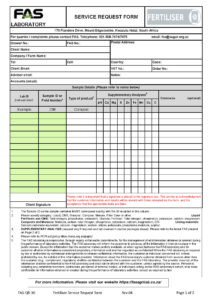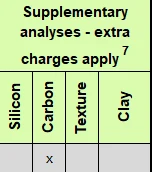 Soils play a vital role in achieving high yields and sustainable production. The soil fertility analysis is a powerful tool that unlocks the secrets held within fields, providing essential information about the nutrient status of the soil. However, submission forms are often incomplete or contain inaccuracies, which can hinder the ability to provide the most precise and effective fertiliser recommendations.
Soils play a vital role in achieving high yields and sustainable production. The soil fertility analysis is a powerful tool that unlocks the secrets held within fields, providing essential information about the nutrient status of the soil. However, submission forms are often incomplete or contain inaccuracies, which can hinder the ability to provide the most precise and effective fertiliser recommendations.
This article provides clear instructions for accurately completing the soil fertility analysis submission form, emphasising the importance of each section and how the data informs fertiliser recommendations tailored to sugarcane. Accurate submissions support more efficient fertiliser use, cost savings, and improved yields.
The form consists of two parts: grower details (client details box) and sample information. Complete all fields clearly, either manually or in Excel, and ensure all details match those on the submitted samples. For assistance with interpreting results, visit: Understanding FAS Soil Reports.
Client details box

- Grower No: This is the unique number issued to a sugarcane farmer when registering at a specific mill. This is linked to their SASA account for invoicing purposes. Growers will be assigned a unique FAS number to assist in correct report and billing information dissemination. If you are a first-time user, this will be allocated.
- Grower name: Name of the grower or farm and postal address of the client that will be responsible for payment.
- Farm name: Farm where sample was collected.
- Extension Region/City: >Allows FAS to include relevant regional Extension Officer when sending out the report.
- Vat No: Include if Vat number if required on the invoice for tax purposes.
- Order No: Include if this has been allocated prior to sample submission.
- Advisor Name/email: If the reports need to be emailed to an advisor, include their email address.
- Tel/Cell/Fax/Email: Primary email of the client to whom the report and invoice must be sent. Relevant contact numbers for the grower (or representative for the farm) should be included.
Sample details

- ID or Field Number: This will be used by you. It is the identification of the sample for your own records. It should also correspond to the ID or Field number on the sample box label.
- Sample depth (cm): This is important for differentiating between topsoil and subsoil. Remembering that fertiliser recommendations are based om 0 – 20 cm while gypsum recommendations are based on the whole soil profile.
- Crop type (name of the crop): This is important to specify because recommendations for sugarcane are generated automatically, while they must be requested for other crops.

- Are recommendations required? (Y/N): Specify this if the crop is not sugarcane.
- Is the crop irrigated? (Y/N): This information is important for the formulation of K recommendations because higher K application rates are used for irrigated regions, e.g. recommendations of 200 and 250 kg K/ ha for target yields of 150 t/ ha for rainfed and irrigated regions, respectively.
- Target yield: NPK recommendations are linked to this value, e.g. cat 2 soils with target yield of 75 t/ ha would receive a recommendation of 110 kg N/ ha while 150 t/ ha would get 190 kg N/ ha. Similar approach is used for P and K where there are higher recommendations for higher target yields.
- Crop cycle or age: This will affect NPK, lime and gypsum recommendations and split applications for N. N recommendations are reduced for plant crop compared to ratoons and this accounts for N mineralisation with planting, e.g. cat 2 soils with 75 t/ ha yield target would get 110 and 140 kg N/ ha for plant and ratoon crop, respectively. For P, it assumed that the fertiliser is applied in furrow for plant crop while for ratoon it is assumed that it is top-dressed and this will influence the recommendations. Similarly for K, maximum recommendations of 100 kg K/ ha for furrow application are recommended for plant crop and remainder should be broadcasted.

- Is the cane mulched (Y/N)? This will influence the N carrier recommendations. Also, K recommendations are reduced if there is trashing.
- Green manure (Type and yield): Here, indicate if you had a green manure crop before planting and what it was e.g. sunn hemp, oats, soybean, etc. Also, indicate the yield as either Low, Average or High. N recommendations are reduced according to the green manure crop and its yield. This applies to the plant crop only.

Supplementary analyses – extra charges apply: Fill this part if you require supplementary analysis, these are offered at an extra charge. Carbon and clay percentage are estimated using MIR in the routine analysis and if the use of traditional methods is necessary their supplementary analysis could be requested. Silicon and texture are only offered as supplementary analyeis.

